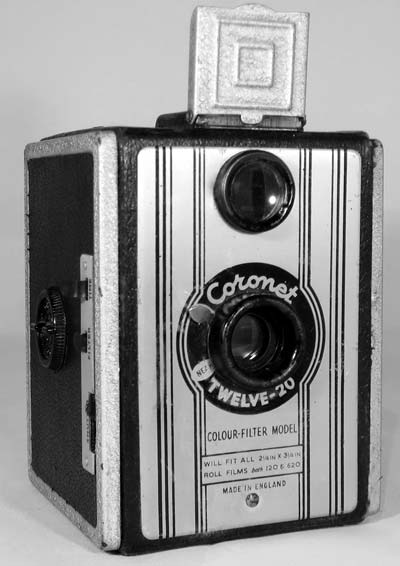Coronet Twelve-20 Colour Filter Model
Specification

| Manufacturer | : | Coronet |
|---|---|---|
| Produced | : | 1950 |
| Classification | : | Medium Format |
| Body Type | : | Pseudo twin lens reflex box |
| Construction | : | Metal, Cardboard, Plastic |
| Film Type | : | 120/620 |
| Film Width | : | 62mm |
| Image Size | : | 2¼ x 2¼ |
| No. of Images | : | 12 |
| Lens Type | : | Meniscus |
| Focal Length | : | 75mm |
| Focus Type | : | Variable |
| Focal Range | : | 7ft - Inf. |
| Aperture Type | : | fixed |
| Apertures | : | f/16 |
| Shutter Type | : | Rotary |
| Shutter Speeds | : | T/I(1/25s) |
| Size (w x h x d) | : | 95 x 120 x 87 mm |
| Weight | : | 400g |
Art Deco Credentials
![]()
![]()
Acceptable: Modest and restricted
- Produced after the main Art Deco period.
- Vertical lines to face in triplets.
- Raised Square design on viewfinder.
Description
The Coronet Twelve-20 colour-filter model had a variety of designs having different functions available. Functions included variable focus, lime green filter and variable aperture. The one shown above is the colour filter model. It can be described as a pseudo twin lens reflex camera. It isn't a true TLR because the top lens is just part of the viewfinder and does not aid focussing.
The body construction is a metal frame and sides, with the front, back, top and bottom made of cardboard. It has a plastic box internally covering the mechanism. The reflex style brilliant viewfinder give a fairly clear image. The viewfinder is provided with a cover.
This model has a T/I shutter. The time mode is selected by pulling out a tab on the side. Another tab is used to select the lime green filter. There is a lever on the front that can be moved to two positions to change the focus. The two positions are annotated 'Dist' and 'Near'.
A turn-key on the side releases the other side of the camera to load the film. Film advance is by a knob on the side and exposures are counted using a red window which has a swinging metal cover. The camera has a dual purpose spindle drive and will accept both 120 and 620 formats. It does not have a tripod mount. It normally comes with a poor quality plastic strap.
How to Use
This camera takes 120 film which is easily available. It has a single aperture setting at f/16.
The yellow filter is often used to produce more contrast between clouds and blue sky when B/W film is being used. It can also be useful to reduce exposure by about 1 stop.
With a shutter speed of only 1/25 sec, make sure you brace the camera against your body or something solid and press the shutter smoothly to avoid camera shake.
If you don't want to bother with an exposure meter, follow the guide shown. It is based on the 'Sunny 16' rule. Film is so forgiving and will produce acceptable results even when over-exposed by 2 or 3 stops or under-exposed by 1 stop.
The table shown assumes the shutter speed is about 1/25s.
The table also assumes that the sun is at least 30 degrees above the horizon - that's 10am - 5pm on a summers day in the UK.
Remember that the exposure guide in the manual may not be helpful as it is based on the use of old film with a low ISO value.
Using ISO 100/125 film - shutter speed 1/25s
| Weather Conditions | Shadow Detail | Aperture | Exposure |
|---|---|---|---|
 Sunny SunnySnow/Sand | Dark with sharp edges | f/16 | +3 Stop Overexposed Acceptable |
 Sunny Sunny | Distinct | f/16 | +2 Stops Overexposed Acceptable |
 Slight Overcast Slight Overcast | Soft around edges | f/16 | +1 Stop Overexposed Acceptable |
 Overcast Overcast | Barely visible | f/16 | Good |
 Heavy Overcast Heavy Overcast | None | f/16 | -1 Stop Underexposed Acceptable |
 Open Shade Open Shade/Sunset | None | f/16 | -2 Stops Underexposed Not Acceptable |